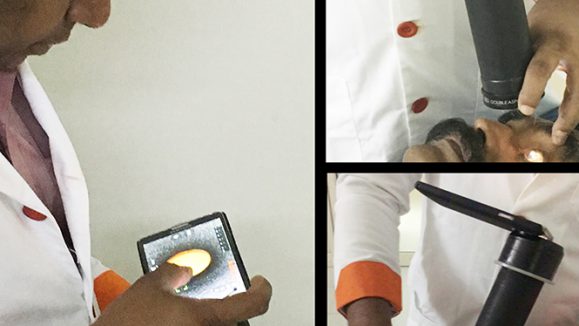Thanks to technological advances in computer imaging, an idea to treat retinal detachment is gaining ground.
The retina of the eye is comprised of mostly photosensitive cells. Damage to the retina, from mechanical impact, excessive straining of the eye, or diabetes, can lead to retinal detachment resulting in partial or total loss of vision, if left untreated.
There are already a number of treatments for retinal reattachment: laser surgery (tissue scarring), cryopexy (freeze treatment), scleral buckling, or inserting fluid into the eye. Regardless of the method, the main idea behind the treatments is to increase the force pushing on the detached retina to facilitate reattachment between the tissues in the eye.
Retinal repair procedures have been shown to have a high success rate; however, loss of vision is still a frequent setback after surgery for a number of patients. “Sight is inevitably the most important sense for anyone and its impairment has a negative effect on both the individual and on society,” said Dr. Razvan Rusovici, one of the authors of a recently published paper on a novel surgical procedure that takes a more patient-focused approach to treating retinal detachment.
This new surgical procedure involves inserting a stent into the patient’s eye to create pressure, allowing the retina to reattach, an idea that was designed and patented by Dr. Ganiban and his company OptiStent (Rockledge, FL, USA). Of course, any new development in healthcare must undergo rigorous testing before it can be considered as a viable treatment option, and Dr. Rusovici and a team of scientists at Florida Institute of Technology are doing just that.
This new approach utilizes a titanium alloy stent that is surgically inserted into the patient’s eye. The insertion of the stent itself is facilitated by a medical catheter-like device that acts as an expandable pressurized balloon inside the eye to gently press the retina back into contact with the choroid and sclera. As opposed to a self-expanding stent, it would allow more accurate control over the applied pressure, as research has shown that self-expandable stents may continue to slowly expand post-implantation, and thus induce too much strain on the sclera – which could permanently damage the eye.
Fortunately for doctors, like Dr. Rusovici, with innovative ideas for improvements to patient care and surgical procedures, computers can be used to create models to design medical devices and anticipate problems before they arise in an actual patient.
In this new approach, designing a stent that would serve its purpose, and not damage the eye in the process, is key – and there are a number of factors to consider: too much pressure on the retina could lead to irreversible retinal damage at the stent-retina interface; or insufficient pressure, on the other hand, could potentially allow the stent to lose contact and move within the eye cavity. Furthermore, since eye tissue properties, including intraocular pressure may vary significantly between patients, but also within the eye of a single patient throughout a day, the design of an “ideal stent” is a challenging task.
To overcome this hurdle, Dr. Rusovici and colleagues have used a 3-dimensional computational model to identify a given stent configuration (diameter and specific geometric shape) that would induce high enough additional intraocular pressure, but not exceed the maximum allowable threshold that would lead to permanent retinal damage. The study showed that the maximum strain occurred at the contact between retina and the apex of the loops of the stent, making it a feasible strategy for retinal reattachment procedure, and providing a theoretical basis for the experimental implementation of the new procedure.
Despite the proof of concept, the authors strongly emphasize the importance of careful stent design and analysis for proper patient treatment, as certain combinations of stent geometry and intraocular pressure could lead to retinal strains too close or above the permanent damage threshold.
With these results, the retinal repair procedure has a strong theoretical starting point and will hopefully continue experimentally. “I feel fortunate if my research could bring a small contribution to the understanding and treating of eye injuries”, shared Dr. Rusovici, who is personally invested in this research due to family history of ophthalmic diseases.
Reference:
Rusovici R, Dalli D, Mitra K, et al. Finite element modeling, validation, and parametric investigations of a retinal reattachment stent. Int J Numer Method Biomed Eng. 2017 Mar 27. [Epub ahead of print]




